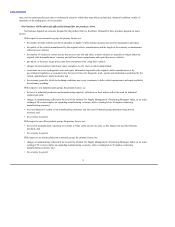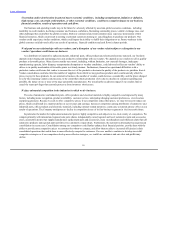Napa Auto Parts 2010 Annual Report Download - page 20
Download and view the complete annual report
Please find page 20 of the 2010 Napa Auto Parts annual report below. You can navigate through the pages in the report by either clicking on the pages listed below, or by using the keyword search tool below to find specific information within the annual report.
Table of Contents
Cost of Goods Sold
Cost of goods sold was $8.0 billion, $7.0 billion and $7.7 billion in 2010, 2009 and 2008, respectively. The 13% increase in cost
of goods sold from 2009 to 2010 is directly related to the sales increase for the same period. Cost of goods sold represented 71.0% of net
sales in 2010, 70.1% of net sales in 2009 and 70.3% of net sales in 2008. The increase in cost of goods sold as a percent of net sales in
2010 relative to 2009 and 2008 reflects the impact of certain pricing adjustments implemented in Automotive during 2009 as well as
ongoing competitive pricing pressures in Office. These factors more than offset our gross margin initiatives to enhance our pricing
strategies, promote and sell higher margin products and minimize material acquisition costs.
In 2010, all four of our business segments experienced vendor price increases, although the Automotive and Office increases were
relatively immaterial. In 2009, our Office and Electrical business segments experienced vendor price increases. Industrial was flat and
Automotive pricing was down for the year. In 2008, all four of our business segments experienced vendor price increases. In any year
where we experience price increases, we are able to work with our customers to pass most of these along to them.
Operating Expenses
Selling, administrative and other expenses (“SG&A”) increased by $147 million or 7% to $2.4 billion in 2010, representing 21.1%
of net sales and down from 22.1% of net sales in 2009. SG&A expenses as a percentage of net sales improved from the prior year due
primarily to the benefit of greater expense leverage associated with the 11% sales increase for the year. In addition, management’s ongoing
cost control measures in areas such as personnel, freight, fleet and logistics have served to further improve the Company’s cost structure.
After reducing the size of its workforce by approximately 12% during 2008 and 2009, the Company added back only 1% of that in 2010
(including acquisitions), despite the 11% increase in revenues. In total, of the estimated $70 million cost savings in 2009, the Company
estimates that it added back approximately $20 million in costs in 2010, primarily associated with the increase in sales and earnings. Our
management teams remain focused on the ongoing assessment of the appropriate cost structure in our businesses. Depreciation and
amortization expense in 2010 was $89 million, down slightly from 2009. The provision for doubtful accounts was $11 million in 2010,
down 61% from $28 million in 2009. The decrease in bad debt expense reflects a much improved collections environment in 2010
relative to the prior year. We believe the Company is adequately reserved for bad debts at December 31, 2010.
In 2009, SG&A was $2.2 billion, down $140 million or 6% from 2008 and representing 22.1% of net sales. This compared to
21.4% of net sales in 2008. This percentage increase was primarily due to the loss of expense leverage associated with the 9% sales
decrease for the year. During 2009, management implemented extensive cost control initiatives to offset this loss of leverage. These
measures eliminated approximately $70 million in operating costs and helped drive the decrease in absolute SG&A dollars for the year.
Depreciation and amortization expense in 2009 was $90 million, up slightly from 2008. The provision for doubtful accounts was
$28 million in 2009, up 17% from a $24 million bad debt expense in 2008.
Total share-based compensation expense for the years ended December 31, 2010, 2009 and 2008 was $7.0 million, $8.6 million,
and $13.0 million, respectively. Refer to Note 5 of the Consolidated Financial Statements for further information regarding share-based
compensation.
Non-Operating Expenses and Income
Non-operating expenses consist primarily of interest. Interest expense was $28 million in 2010 and 2009 and $32 million in 2008.
The decrease in expense relative to 2008 is the result of an improved interest rate on certain long-term debt, effective November 2008.
In “Other”, interest income net of noncontrolling interests has increased in each of the last two years due primarily to our improved
cash position and the elimination of certain noncontrolling interests in 2009.
Income Before Income Taxes
Income before income taxes was $762 million in 2010, an increase of 18.3% from $644 million in 2009. As a percentage of net
sales, income before income taxes was 6.8% in 2010, reflecting an increase from 6.4% in 2009. In
19
























